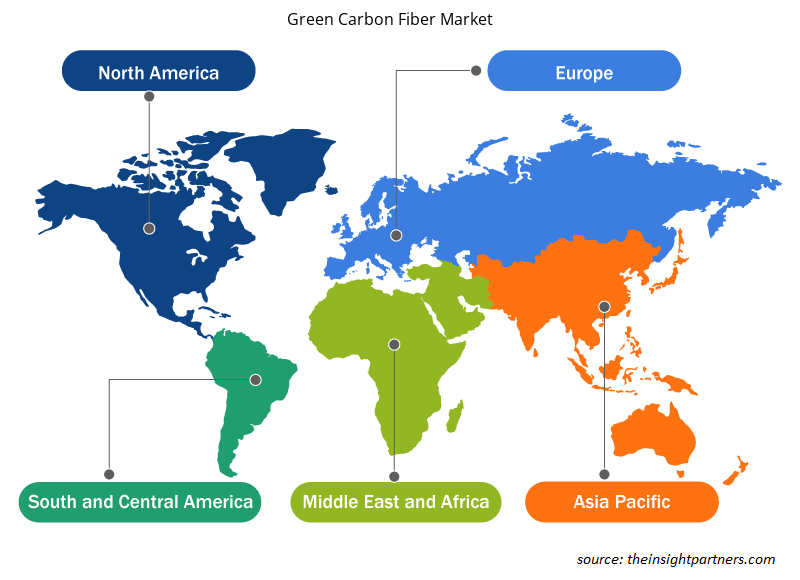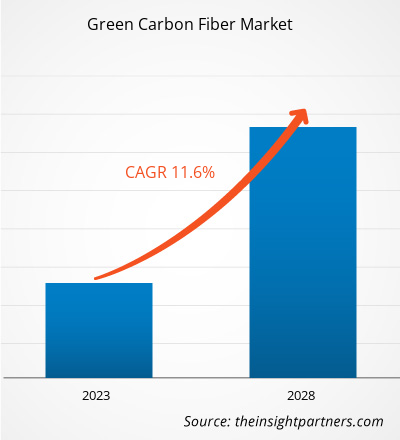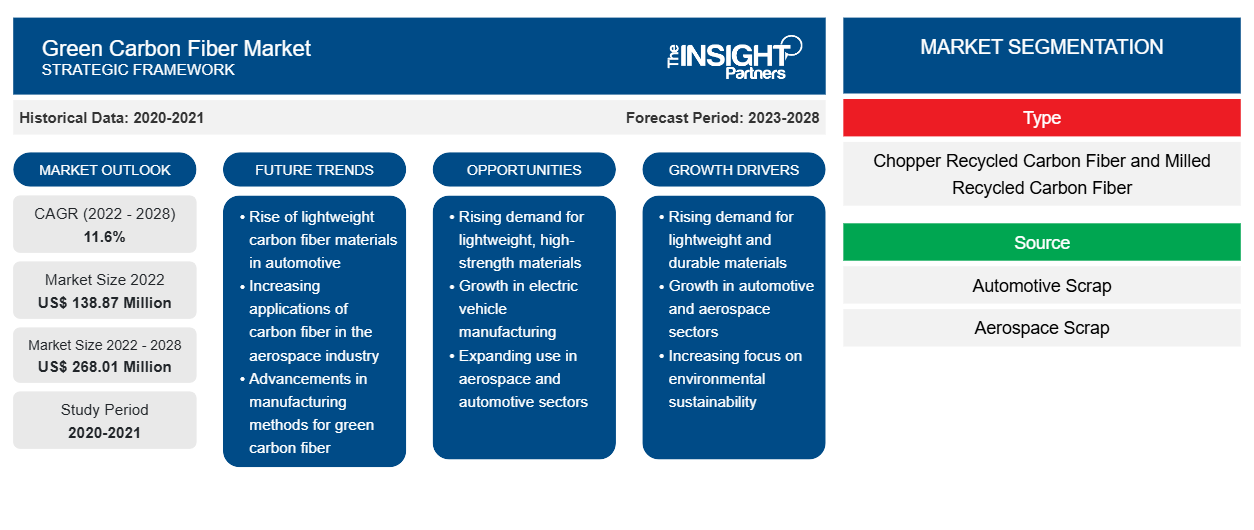[연구 보고서] 녹색 탄소 섬유 시장은 2022년에 1억 3,887만 달러 규모로 평가되었으며, 2028년에는 2억 6,801만 달러에 도달할 것으로 예상됩니다. 2022년부터 2028년까지 연평균 성장률은 11.6%가 될 것으로 예상됩니다.
녹색 탄소 섬유는 재활용 탄소 섬유입니다. 탄소 섬유 재활용은 탄소 섬유 강화 복합재(CFRC)에서 섬유를 회수하는 것입니다. 탄소 섬유 폐기물에는 두 가지 유형이 있습니다. 첫 번째 유형의 폐기물은 버진 탄소 섬유입니다. 즉, 건조 섬유에서 생성된 제품의 찌꺼기와 사용되지 않은 만료된 재료이며 이를 스크랩이라고도 합니다. 녹색 또는 재활용 탄소 섬유는 다양한 최종 사용 분야에서 새롭고 고성능 부품을 제조하는 데 사용됩니다. 자동차, 항공우주, 풍력 에너지, 스포츠 용품 등과 같은 다양한 최종 사용 산업에서 비용 효율적인 경량 소재에 대한 수요가 증가함에 따라 녹색 탄소 섬유의 이점이 녹색 탄소 섬유 시장 성장을 뒷받침하고 있습니다.
2022년에 아시아 태평양은 글로벌 그린 탄소 섬유 시장 에서 가장 큰 점유율을 차지했으며 , 유럽은 예측 기간 동안 가장 높은 CAGR을 기록할 것으로 추정됩니다. 아시아 태평양 그린 탄소 섬유 시장은 중국, 일본, 인도, 한국, 호주 및 기타 아시아 태평양 지역으로 세분화됩니다. 아시아 태평양의 항공우주 및 방위 산업은 지난 몇 년 동안 상당히 성장해 왔습니다. 아시아 태평양에서 중국은 가장 큰 항공기 제조업체 중 하나이며 국내 항공 승객을 위한 가장 큰 시장 중 하나입니다.
귀하의 요구 사항에 맞게 이 보고서를 사용자 정의하세요
이 보고서의 일부 또는 국가 수준 분석, Excel 데이터 팩을 포함하여 모든 보고서에 대한 사용자 정의를 무료로 받을 수 있으며 신생 기업 및 대학을 위한 훌륭한 혜택과 할인 혜택을 이용할 수 있습니다.
-
이 보고서의 주요 시장 동향을 알아보세요.이 무료 샘플에는 시장 동향부터 추정 및 예측까지 다양한 데이터 분석이 포함됩니다.
COVID-19 팬데믹이 그린 탄소섬유 시장에 미치는 영향
중국, 인도, 일본 등 아시아 태평양 국가들은 COVID-19 팬데믹 동안 제조 시설 폐쇄, 공급망 중단, 원자재 부족으로 인해 상당한 어려움에 직면했습니다. 이로 인해 제품 제조 및 유통이 크게 침체되었습니다. 그럼에도 불구하고, 팬데믹은 아시아 태평양의 그린 탄소 섬유 시장에서 활동하는 주요 업체들에게 몇 가지 수익성 있는 기회를 가져다주었습니다. 그린 탄소 섬유 시장의 많은 회사들은 이 기회를 잡고 판매를 늘리기 위해 COVID-19의 두 번째 물결 중 또는 이후에 제품을 판매하기 위해 정부 프로토콜과 규범을 시행하기 시작했습니다. 따라서 정부의 지지는 지속 가능한 탄소 섬유에 대한 수요를 증가시키고 그린 탄소 섬유 시장 성장을 급증시키는 경향이 있습니다.
시장 통찰력
풍력 에너지 산업에서 녹색 탄소 섬유 사용 증가로 녹색 탄소 섬유 시장이 성장
전 세계 여러 나라가 기후에 해로운 재생 불가능한 화석 연료에서 깨끗하고 재생 가능한 에너지원으로 전환함에 따라 풍력 터빈에 대한 수요가 빠르게 증가하고 있습니다. 또한 전기 요금 상승으로 재생 에너지원에 대한 필요성이 커지고 있습니다. 미국, 독일, 사우디 아라비아, 중국 등 여러 국가의 정부가 재생 에너지를 생산하기 위한 이니셔티브를 취함에 따라 풍력 에너지 시장이 성장하고 있습니다. 재생 에너지원, 특히 풍력 에너지에 대한 수요 증가와 화석 연료 기반 발전에 대한 의존도를 줄이려는 노력은 풍력 에너지 부문의 성장에 중요한 요인이며, 결국 녹색 탄소 섬유 시장 성장을 촉진합니다.
순수 탄소 섬유(VCF)로 강화된 폴리머는 풍력 터빈 블레이드의 스파 캡을 만드는 데 사용되고 있으며, 유리 섬유가 포함된 폴리머는 블레이드 구성 요소의 스킨을 만드는 데 사용됩니다. 그러나 재활용 탄소 섬유 하이브리드 블레이드가 12~89% 더 나은 환경 성능을 제공함에 따라 현재 풍력 터빈에서 녹색 탄소 섬유가 널리 사용되고 있습니다. 재활용 탄소 섬유 하이브리드 블레이드의 에너지 및 탄소 회수 기간은 시장 기존 제품보다 5~13% 낮았습니다. 풍력 터빈 블레이드 부품에 재활용 탄소 섬유를 사용하는 것은 기계적으로 실행 가능하며 유리 섬유에 비해 상당한 환경적 이점을 제공합니다. 탄소 섬유의 이러한 특징적인 특성은 더 나은 풍력 블레이드 터빈과 더 높은 에너지 생산을 생산하는 데 도움이 되었습니다. 따라서 풍력 에너지 산업에서 녹색 탄소 섬유의 사용이 증가함에 따라 시장 성장이 촉진되고 있습니다.
유형 기반 통찰력
그린 탄소 섬유 시장은 유형에 따라 초퍼 재활용 탄소 섬유와 밀링 재활용 탄소 섬유로 나뉩니다. 밀링 재활용 탄소 섬유 세그먼트는 2022년에 시장 점유율이 더 높았습니다. 밀링 재활용 탄소 섬유는 초퍼 섬유를 분말(밀링) 형태로 분쇄하여 만듭니다. 밀링 재활용 탄소 섬유의 일반적인 길이는 80~100마이크로미터입니다. 이 섬유는 정전기 소산과 강도를 제공합니다.
소스 기반 통찰력
출처에 따라 녹색 탄소 섬유 시장은 자동차 폐기물, 항공우주 폐기물 및 기타로 세분화됩니다. 자동차 폐기물 부문은 예측 기간 동안 가장 높은 CAGR을 기록할 것으로 예상됩니다. 재활용 탄소 섬유는 자동차 탄소 섬유 강화 플라스틱(CFRP) 제조에서 ~40~60%의 폐기물 양에서 얻을 수 있습니다. 재활용 탄소 섬유를 사용하면 자동차 제조업체가 차량에서 더 많은 마일리지를 달성하는 데 도움이 될 수 있습니다.
애플리케이션 기반 통찰력
응용 프로그램을 기준으로 녹색 탄소 섬유 시장은 항공우주, 자동차, 풍력 에너지, 스포츠 용품 등으로 세분화됩니다. 자동차 부문은 2022년에 가장 큰 시장 점유율을 차지했습니다. 자동차 산업은 재활용 탄소 섬유를 사용하여 섀시 패널, 바닥, 루프 패널, 스페어 휠 웰, 부트 또는 보닛 내부를 만드는 경우가 많습니다.
이 회사는 건조 탄소 섬유를 재활용하기 위해 폐쇄 루프 공정을 사용합니다. 재활용 탄소 섬유를 사용한 자동차의 생산 비용은 강철의 생산 비용보다 비교적 낮습니다. 또한 재활용 탄소 섬유는 강철의 경우와 달리 다양한 모양으로 성형 및 성형할 수 있습니다. 재활용 탄소 섬유의 이러한 특성은 자동차 부문에서 수요를 강화하고 있습니다.
녹색 탄소 섬유 시장에서 활동하는 주요 기업으로는 Procotex Corp SA, Vartega Inc, Sigmatex (UK) Ltd, Shocker Composites LLC, Carbon Conversions Co, SGL Carbon SE, Toray Industries Inc, Gen 2 Carbon Ltd, Catack-H Co Ltd, Innovative Recycling이 있습니다. 이러한 기업은 전 세계적으로 증가하는 소비자 수요를 충족하기 위해 신제품 출시와 지역 확장에 집중하고 있습니다. 이들은 광범위한 글로벌 입지를 갖추고 있어 많은 고객에게 서비스를 제공하고 결과적으로 시장 점유율을 늘릴 수 있습니다. 이러한 시장 기업은 신제품 출시와 지역 확장에 집중하여 특수 포트폴리오에서 제품 범위를 늘립니다.
녹색 탄소 섬유 시장 지역 통찰력
Insight Partners의 분석가들은 예측 기간 동안 Green Carbon Fiber Market에 영향을 미치는 지역적 추세와 요인을 철저히 설명했습니다. 이 섹션에서는 북미, 유럽, 아시아 태평양, 중동 및 아프리카, 남미 및 중미의 Green Carbon Fiber Market 세그먼트와 지리에 대해서도 설명합니다.

- 녹색 탄소 섬유 시장에 대한 지역별 특정 데이터 얻기
그린 탄소 섬유 시장 보고서 범위
| 보고서 속성 | 세부 |
|---|---|
| 2022년 시장 규모 | 1억 3,887만 달러 |
| 2028년까지 시장 규모 | 2억 6,801만 달러 |
| 글로벌 CAGR (2022-2028) | 11.6% |
| 역사적 데이터 | 2020-2021 |
| 예측 기간 | 2023-2028 |
| 다루는 세그먼트 |
유형별로
|
| 포함된 지역 및 국가 |
북아메리카
|
| 시장 선도 기업 및 주요 회사 프로필 |
|
녹색 탄소 섬유 시장 참여자 밀도: 비즈니스 역학에 미치는 영향 이해
그린 카본 파이버 마켓 시장은 소비자 선호도의 변화, 기술 발전, 제품의 이점에 대한 인식 증가와 같은 요인으로 인해 최종 사용자 수요가 증가함에 따라 빠르게 성장하고 있습니다. 수요가 증가함에 따라 기업은 제품을 확장하고, 소비자의 요구를 충족하기 위해 혁신하고, 새로운 트렌드를 활용하여 시장 성장을 더욱 촉진하고 있습니다.
시장 참여자 밀도는 특정 시장이나 산업 내에서 운영되는 회사나 기업의 분포를 말합니다. 주어진 시장 공간에 얼마나 많은 경쟁자(시장 참여자)가 존재하는지 그 규모나 전체 시장 가치에 비해 나타냅니다.
녹색 탄소 섬유 시장에서 운영되는 주요 회사는 다음과 같습니다.
- 프로코텍스 코퍼레이션 SA
- 바르테가 주식회사
- 시그마텍스(영국) 유한회사
- 쇼커 컴포지트 LLC
- 탄소 변환 회사
면책 조항 : 위에 나열된 회사는 어떤 특별한 순서에 따라 순위가 매겨지지 않았습니다.

- Green Carbon Fiber Market의 주요 기업 개요를 알아보세요
스포트라이트 보고서
- 기업의 효과적인 장기 전략 개발을 돕기 위한 녹색 탄소 섬유 시장의 진보적 산업 동향
- 선진국과 개발도상국의 시장 참여자들이 채택한 사업 성장 전략
- 2022년부터 2028년까지의 시장에 대한 정량적 분석
- 녹색탄소섬유에 대한 세계 수요 추산
- 녹색 탄소 섬유 시장에서 구매자와 공급자의 효능을 설명하기 위한 포터의 5가지 힘 분석
- 경쟁 시장 시나리오를 이해하기 위한 최근 개발
- 녹색 탄소섬유 시장의 시장 동향 및 전망, 성장 동인 및 제약
- 상업적 이익을 뒷받침하는 시장 전략을 강조하여 의사 결정 프로세스 지원
- 다양한 노드에서의 녹색 탄소섬유 시장 규모
- 자세한 개요 및 녹색 탄소 섬유 산업 역학
- 성장 가능성이 유망한 다양한 지역의 녹색 탄소 섬유 시장 규모
- 과거 분석(2년), 기준 연도, CAGR을 포함한 예측(7년)
- PEST 및 SWOT 분석
- 시장 규모 가치/거래량 - 글로벌, 지역, 국가
- 산업 및 경쟁 환경
- Excel 데이터세트
최근 보고서
관련 보고서
사용 후기
구매 이유
- 정보에 기반한 의사 결정
- 시장 역학 이해
- 경쟁 분석
- 고객 인사이트
- 시장 예측
- 위험 완화
- 전략 기획
- 투자 타당성 분석
- 신흥 시장 파악
- 마케팅 전략 강화
- 운영 효율성 향상
- 규제 동향에 발맞춰 대응























 무료 샘플 받기 - 녹색 탄소 섬유 시장
무료 샘플 받기 - 녹색 탄소 섬유 시장